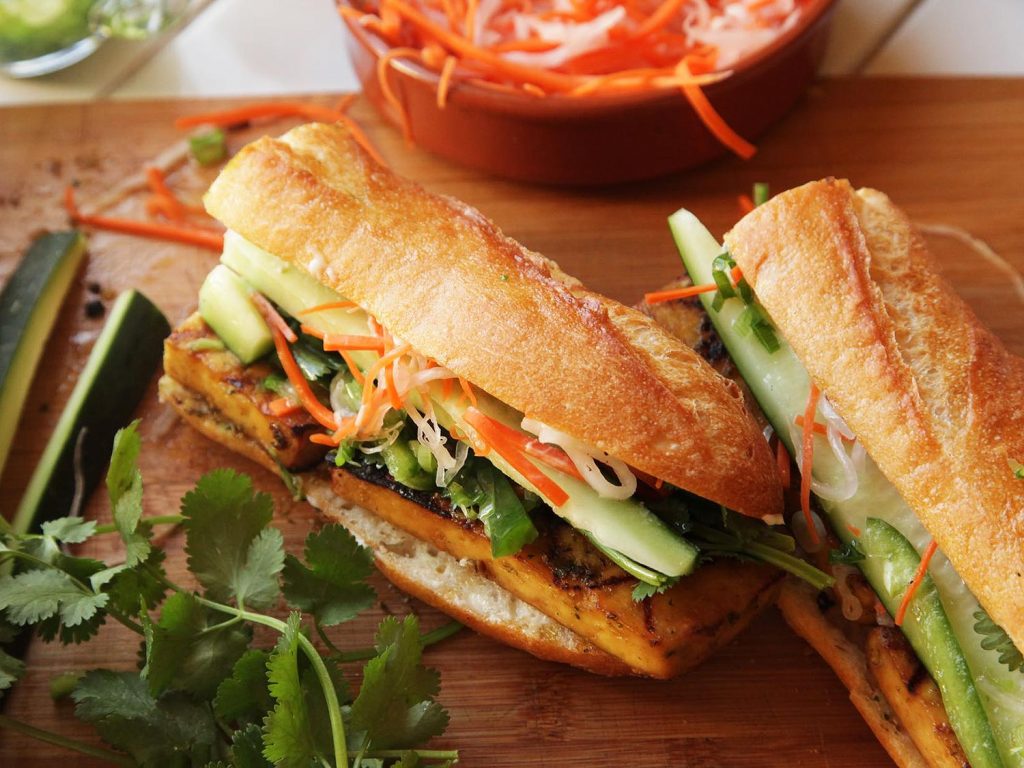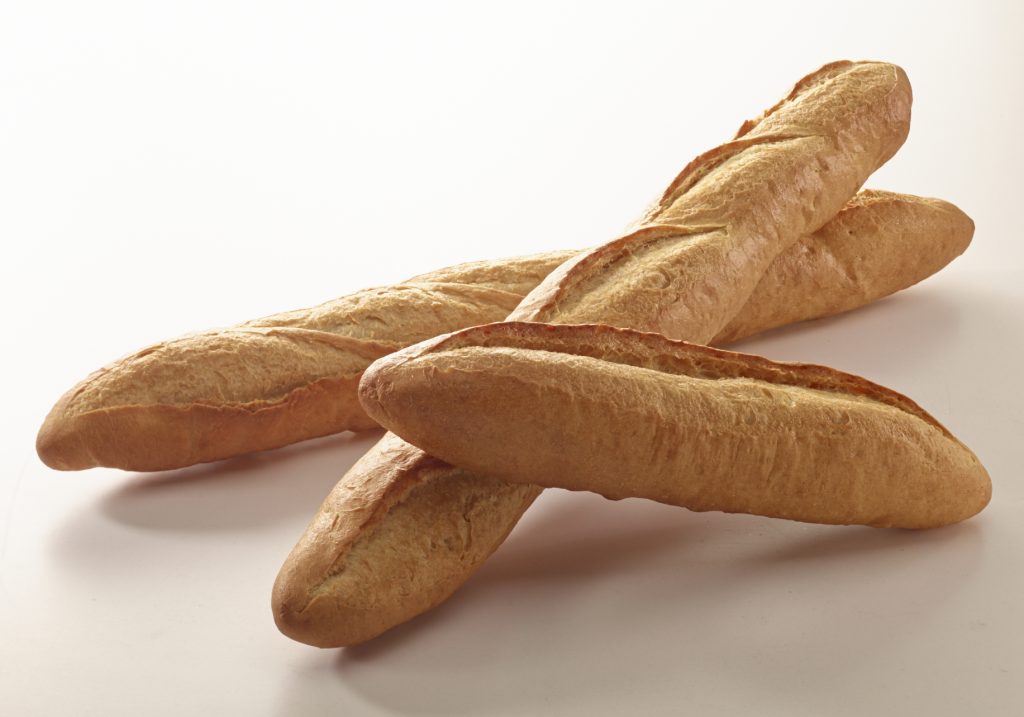So you say you know about baguette
Shanghai Young Bakers, as a charity programme, is deeply connected with French bakery, and it is not a coincidence. After all, French people love bread: according to the French Observatoire du Pain (i.e. Bread Observatory), French people consume 110g to 200g bread per person per day on average for the three main meals of a day, with 68% for breakfast, 80% for lunch and 82% for dinner.[1] And among all kinds of bread, baguette is probably one of the most consumed by French people. According to a tweet by French Ministry for Europe and Foreign Affairs, French people eat about 30 million baguettes per day, an equivalence of 300 per seconds! Since it is a daily bread for French people, there are still baguette delivery service in France. Here is an illustration made by Phoebe Thomas at Lou Messugo to show how baguette can be delivery:

A baguette in a delivery box.
Photo by Phoebe Thomas at Lou Messugo, originally in her blog post ‘Daily Bread – the French Baguette’. According to Thomas, normally the bread should be completely inside with the lid closed, so the bread would beprotected from the weather.
Baguette is probably also one of the most—if not the most—iconic French product. It is so iconic that the current French president Emmanuel Macron wants it to be recognized on UNESCO’s list of Intangible Cultural Heritage.[1] As an integrated part of the culture and the stereotype about France, baguette is also a rather common element in internet memes about French people. For example:

How French people take selfies
Source:GamerPlayer, Memedroid, https://www.memedroid.com/memes/detail/2101118

Source:NewGuy, Memedroid, https://www.memedroid.com/memes/detail/1636730
As silly as they may be, these memes do show the strong influence of baguette. In fact, many people outside of France also love baguette and use it to make sandwiches and other food.

Source:Raphael Nogueira on Unsplash
For example, the largest bakery chain in the United Kingdom, Greggs, offers several baguette-based sandwiches (which they simply call ‘baguette’) in their menu.[1]Formerly colonized by France, Vietnam has a popular street food, bánh mì, which is also a sandwich based on baguette (and you can indeed find bánhmì in some Vietnamese restaurants in Shanghai).

Source:J. Kenji Lopez-Alt from Seriouseats THE VEGAN EXPERIENCE
While being popular, it is often claimed that the origin of baguette is unknown. There are several culinary legends related to the birth of baguette:
>> It was invented after the French Revolution a the Bread of Equality for both the rich and the poor;
>> It was regulated by Napoleon Bonaparte to fit the pockets on the uniforms of the French army;
>> It was requested by the Paris Metro constructor who was looking for a bread that needs no cutting before eating;
>> It was developed because a law forbade bakers from working before 4 a.m. and traditional bread required longer time to bake before the first customer would arrive in the morning.[4]
The Wikipedia entry of baguette suggests that the primitive form of the bread as we know today emerged in 18th century, refined and developed in 19th century with introductions of new ingredients and baking technology, and was first given the name ‘baguette’ in 1920. Speaking of the name, while the word ‘baguette’ seem to be a proper name to non-French speakers, it actually means ‘wand’, ‘baton’ or ‘stick’ in French. A baguette magique is a magic wand used by a wizard, not a magical French bread of some sort!
Although baguette is daily and common for French people, the making and perfection of it is a serious matter. Similar to other parts in the food and beverage industry, traditional French bakery has been under the threats of industrialized production. As a response, France has passed Le Décret Pain (the Bread Law) in 1993, defining that ‘traditional French bread’ (“pain de tradition française”, “pain traditionnel français”, “pain traditionnel de France”) can only be made of drinking water, yeast, salt, and wheat flour (which may contain maximum 2% of broad bean flour, or 0.5% of soy flour, or 0.3% of wheat malt flour); no other additive is allowed, and the bread may be sold under the name of ‘pain maison’ (‘homemade bread’) or equivalent only at the same place where it is baked, or by the bakers of that place.[5]
Every year since 1994, there has been the Grand Prix de la Baguette in Paris, where a jury of experts would decide who in Paris makes the best baguette in that year. The submitted baguette must measure 55-70cm, weight 250-300g and have a salt content of 18g per kilogram of flour.[1] The bread will be judged according to five distinct criteria: la cuisson (baking), le goût (taste), la mie (crumb), l’odeur (smell), and l’aspect (appearance).[2] Such contest not only help preserve and boost the traditional French artisan bakery of baguette, but also contributes to a deeper connections between individuals and the contemporary French society: between 2014-2018, four out of five winners of the annual Le Grand Prix de la Baguette were of African origins, including in 2018 the youngest-ever winner of the competition, Mahmoud M’Seddi, a second generation Tunisian French. (For more on this story, please read BBC’s article, ‘The Perfect French Baguette‘ by Emily Monaco.)
But for those who cannot go to this Grand Prix, how do we know if a baguette is good or not? According to SYB’s own technical director, Xiao Jinjin, a good baguette should be (in terms of colour) golden-brown on the outside, white but perhaps a bit naturally yellow on the inside.

Regarding the texture, a good baguette should be crisp on the outside, and firmon the inside (perhaps similar toal dente for cooked Italian pasta).And when the one grabs the baguette a bit hard, there should be a feeling of cracking on the surface of the baguette.

As this point you may ask: okay but where can I buy authentic baguette in Shanghai? Well, you’ve come to the right place: you will be able to find authentic and delicious French bakery at Shanghai Young Bakers’ booth at Jiashan Market and Commune Market when we attend. All the French bakery, including baguette, will be freshly baked for the markets by SYB’s graduates working at our sister charity café, Village 127. Please remember to check our WeChat official account to see when we will attend a market.
Hema Oct.17-Oct.19
Jin Mao North Bund, Hongkou District, Shanghai
And if you still want more, then you can join of our public classes to learn how make delicious French bakery and pastry. In fact, on Friday, 18 Oct between 10 a.m. and 3 p.m., SYB will be running a public class about Baguette and milky bread at our baking centre.

You will be learning directly from our teachers who have been trained in Aurillac, France before. You will be able to bring the baguette baked by yourself home to share with you family or friends. What’s even better is that while you are attending the class, you are also supporting SYB’s charity programme so that more marginalized Chinese youths can be empowered by high-quality and free French bakery and pastry training. Contact us now to learn more about our public class and we will be very happy to see you!
That’s all for today’s article. The SYB management team hopes you enjoy reading it. If you have any story about baguette or French bakery, or any thought and ideas, feel free to comment below.
>>Reference
[1]L’observatoire du Pain, ‘3 Temps Forts de Consommation Dans La Journée’, Observatoire Du Pain, http://www.observatoiredupain.fr/conso/une-consommation-vivante/3-temps-forts-de-consommation-dans-la-journee_89.aspx [accessed 19 September 2019]
[2] ‘France Demands UN Protection for Baguette’, BBC News, 13 January 2018, section Europe, https://www.bbc.com/news/world-europe-42674724 [accessed 19 September 2019]
[3] See: https://www.greggs.co.uk/sandwiches
[4]Lestz, Margo, ‘History of the Baguette: Legends, Laws, and Lengthy Loaves’, Bonjour Paris, 2015, https://bonjourparis.com/food-and-drink/history-baguette-legends-laws-and-lengthy-loaves/ [accessed 19 September 2019]
[5]Décret N°93-1074 Du 13 Septembre 1993 Pris Pour l’application de La Loi Du 1er Août 1905 En Ce Qui ConcerneCertainesCatégories de Pains, NOR: ECOC9300130D, 1993
[6] See: https://www.paris.fr/pages/goutez-et-choisissez-la-meilleure-baguette-de-paris-6640
[7]See above. Or: Monaco, Emily, ‘The Perfect French Baguette’, BBC, http://www.bbc.com/travel/story/20190825-the-perfect-french-baguette [accessed 19 September 2019]

